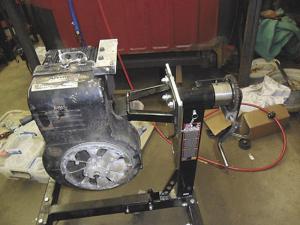2013 - Volume #37, Issue #6, Page #38
[ Sample Stories From This Issue | List of All Stories In This Issue | Print this story
| Read this issue]
Small Engine Stand Makes Repairs Easy
 |
“I wanted to be able to roll up in a chair and be able to move the engine around the shop as I worked on it,” says Maddock. “It lets me take apart an engine, work on it and reassemble it without ever taking it off the stand.”
He started with a commercial H-frame engine stand with an engine support arm. He modified the base and the mounting plate. He cut off all 4 wheels and replaced them with the locking castors. They ensure the stand remains in place, even if it tips so 2 wheels come off the floor.
The original stand allowed the mounting arm and engine to be rotated into one of several fixed positions. Maddock wanted infinite positions, but commercial stands with that option cost several hundred dollars.
The original system involved a round steel shaft that extended through a housing on the stand’s upright and attached to the engine support arm mounting plate. A bar at the rear was turned to rotate the engine into positions at 45° intervals. Maddock replaced the bar with a salvaged worm gear drive from a winch.
"I removed the cable from the winch and attached it to a round ring that I milled to fit over the mounting plate shaft," says Maddock. "The worm drive lets me easily rotate the mounting plate and engine. I use two set screws and a pin to lock the shaft in place. On these light engines, I can pull the set screws and pin, slide the winch off and free wheel the engine."
Since the bulk of the engines he works on are small Briggs & Stratton's, Maddock made a bracket specific for these engines and bolted it in place of the support arm. It bolts to the engines where their starter/generator would normally attach. Other brackets work with larger engines.
If he needs to work on a flywheel, he makes special brackets with a curve for the flywheel. He uses a pipe bender on a piece of steel strap to match the curve of the flywheel. A tab on the end of the curve fits over a fin on the flywheel. Once the bracket is in place, Maddock adds more tabs to “sandwich” multiple fins.
"When you’re trying to torque a flywheel off or on, it wants to lift constantly, and you need someone to hold the engine down," says Maddock. "With this, I can torque the flywheel myself."
Maddock has also fabricated a front engine support for his Simplicity garden tractor. It bolts to the mounting plate.
"It lets me rotate the front end for welding new bearings in place and other work," says Maddock. "Whether front end or engine, the worm gear lets me adjust them as little or as much as I want."
Contact: FARM SHOW Followup, Jerry Maddock, 29197 Standley Rd., Defiance, Ohio 43512 (ph 419 395-1594; jmachine@ayersvilletelco.com).

Click here to download page story appeared in.

Click here to read entire issue
To read the rest of this story, download this issue below or click here to register with your account number.




